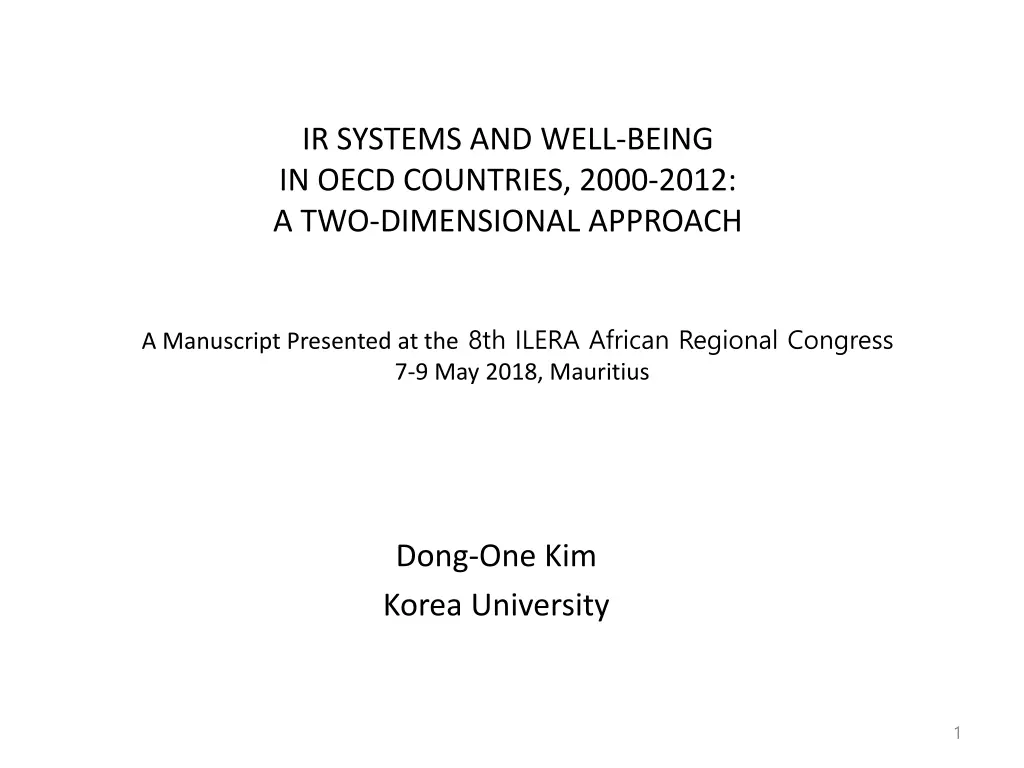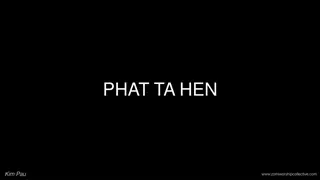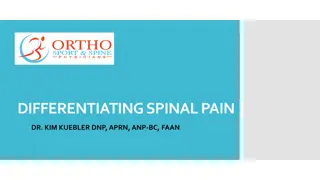
IR Systems & Well-Being in OECD Countries 2000-2012
Explore the impact of national industrial relations systems on society's well-being through a two-dimensional approach focusing on efficiency and equity. This study delves into how an unbalanced pursuit of efficiency over equity can lead to negative consequences, with implications for broader societal issues such as income inequality and labor disputes.
Download Presentation

Please find below an Image/Link to download the presentation.
The content on the website is provided AS IS for your information and personal use only. It may not be sold, licensed, or shared on other websites without obtaining consent from the author. If you encounter any issues during the download, it is possible that the publisher has removed the file from their server.
You are allowed to download the files provided on this website for personal or commercial use, subject to the condition that they are used lawfully. All files are the property of their respective owners.
The content on the website is provided AS IS for your information and personal use only. It may not be sold, licensed, or shared on other websites without obtaining consent from the author.
E N D
Presentation Transcript
IR SYSTEMS AND WELL-BEING IN OECD COUNTRIES, 2000-2012: A TWO-DIMENSIONAL APPROACH A Manuscript Presented at the 8th ILERA African Regional Congress 7-9 May 2018, Mauritius Dong-One Kim Korea University 1
Introduction What are antecedents of well-being? Most political and ideological debates ultimately focused on construction of appropriate policies and the enhancement of quality of life Characteristics of IR system may be considerable antecedent of well-being Critical human needs are met through work and employment IR system, as a subsystem of a national system, is an important factor that influence a nation s level of health and well-being Present study examines impact of national IR systems on broader society Classic IR theorists focused on the impacts of IR on directly work-related issues such as industrial democracy (Webb and Webb, 1897), web of rules (Dunlop, 1958), and the two faces of unionism (Freeman and Medoff, 1984) This study expands the potential range of IR outcomes by investigating international variation in happiness and social problems of crime, suicide, and family break-up 2
Two-dimensional IR approach Country s state of IR can be assessed with two dimensional index of efficiency and equity (Barbash, 1984; Meltz, 1989) This methodology sees IR s two core objectives as efficiency and equity (Kim et al., 2014) Efficiency: maximizing output with minimum input Country with high efficiency in IR: free to utilize HR efficiently; workers circulating freely; IR systems supporting minimization of HR transaction costs Equity: satisfaction of both procedural /distributive justice Country with high level of equity in IR: enjoys high level of social consultation on labor rights and human dignity; system of distributive and procedural justice institutionalized among employers, unions and state 3
Efficiency prevailed over equity in early 21stcentury According to pluralistic philosophy, if public policy tilts to one extreme, undesirable consequences for society will result Excessive emphasis on efficiency at expense of equity Leads to wage gaps and income inequality Results in labor disputes or other forms of employee resistance in both workplace and wider society Focusing on equity alone Weakens the basis of economic activity by lessening motivational potential of capitalism Leads to labor market rigidity, free-rider problems, and lack of innovation Period (2000-2012) covered by this paper was one in which efficiency concerns prevailed over equity concerns after Thatcher-Reagan era Present study s hypotheses based on view that unbalanced pursuit of efficiency likely to have negative consequences; relatively greater emphasis on equity likely to produce desirable results 4
Hypotheses One-sided pursuit of IR efficiency while ignoring IR equity undermines happiness Result in excessive competition and lack of IR equality Increasing income inequality reduced happiness in U.S. and Europe (Helliwell et al., 2015) Growing inequality started to undermine life satisfaction after a few years of rapid economic transformation in Poland (Grosfeld and Senic, 2010) IR equity promotes happiness Equity is the satisfaction of both procedural and distributive justice by guaranteeing human dignity and human rights Equity helps to build cooperative and supportive relationships among co-workers, one dimension of human happiness (Lu and Argyle, 1991) Happiness is enhanced by companionship, and social support (Borooah, 2006) Hypothesis 1A. In this period, efficiency emphasis in a national IR system is negatively related to happiness. Hypothesis 1B. In this period, equity emphasis in a national IR system is positively related to happiness. 5
Hypotheses Two theories, one conclusion Relative income hypothesis (RIH) Lack of equity detrimental to social cohesion and social trust, in turn increases personal stress and mortality, at least for developed countries (Wilkinson, 1996) Relative socioeconomic inequality affects negatively health primarily through psychosocial stress (Wilkinson and Pickett, 2009; Pickett and Wilkinson, 2015) Psychosocial environment theory Lack of equity affects life expectancy through two main pathways: stress and behavior (Wilkinson, 1996) Low economic status leads to chronic anxiety, production of stress hormones such as cortisol and adrenaline high blood pressure, weak immune system, obesity, and heart disease (Marmot et al., 1984) Hypothesis 2A. In this period, efficiency emphasis in a national IR system is negatively related to life expectancy. Hypothesis 2B. In this period, equity emphasis in a national IR system is positively related to life expectancy. 6
Hypotheses Suicide not collection of individual actions but social phenomenon (Durkheim, 1951) Social networks, trust, and social ties are important social institutions that reduce likelihood of suicide (Berkman et al., 2000; Helliwell, 2007) Unilateral pursuit of IR efficiency in national system while ignoring IR equity Encourages competition between individuals, reduces the level of trust among co-workers, and precipitates depression (Rosenfeld, 2000) Leads to weak social bonds, networks, and trust, meaning that suicidal individuals less likely to be rescued by others Societies emphasizing equity over efficiency Stronger social ties between individuals reduce social isolation and depression Individuals less likely to commit suicide in this environment Hypothesis 3A. In this period, efficiency emphasis in a national IR system is positively related to the suicide rate. Hypothesis 3B. In this period, equity emphasis in a national IR system is negatively related to the suicide rate. 7
Hypotheses Unilateral pursuit of IR efficiency in a national system while ignoring IR equity Greater inequality and resultant low social capital among marginal population elevated stress level and corresponding higher rate of violence In turn, violence increases stress and anxiety within a population and ultimately crimes, i.e. vicious cycle (Kawachi et al., 1997) Leads to large income inequality and causes political and social systems to engage in unethical behavior such as bribery and corruption Societies emphasizing equity over efficiency Political and social system more supportive of unemployed and low wage earners Likely to increase social cohesion and trust, decrease levels of violence, and discourage corruption and lower rate of crime and incarceration Hypothesis 4A. In this period, efficiency emphasis in a national IR system is positively related to prison population size. Hypothesis 4B. In this period, equity emphasis in a national IR system is negatively related to prison population size. 8
Hypotheses Unilateral pursuit of IR efficiency in a national system while ignoring IR equity Intensifies interpersonal competition and social hierarchies, which affects social anxiety level and class conflict by eroding social trust and cohesion (Marmot et al., 2008; Uslaner, 2002) Societies in efficiency-oriented system more likely to suffer not only higher crime rates generally, but also higher rate of violent crime such as homicide Homicide found to be more common in more unequal societies (Hsieh and Pugh, 1993) Societies emphasizing equity over efficiency Higher level of mutual support and trust among working population, and higher income equality Corresponding lower rate of competition and social anxiety, class conflict, violence and homicide Hypothesis 5A. In this period, efficiency emphasis in a national IR system is positively related to the homicide rate. Hypothesis 5B. In this period, equity emphasis in a national IR system is negatively related to the homicide rate. 9
Hypotheses Numerous studies concluded that work-family balance is important factor affecting decision to divorce Absence of work-life balance causes marital instability (May, 1980; Riley, 1991; Thornton, 1989) Unilateral pursuit of IR efficiency in national system while ignoring IR equity At organizational level, encourages fierce competition among companies, and makes work systems more stressful for employees with family At individual level, leads to competitive and performance-driven work, long working hours and lack of workplace support, making work-life balance more difficult Societies emphasizing equity over efficiency Promotes individual human rights and quality of life rather than focusing solely on competition among companies Promotes work-life balance at both organizational and individual level Hypothesis 6A. In this period, efficiency emphasis in a national IR system is positively related to the divorce rate. Hypothesis 6B. In this period, equity emphasis in a national IR system is negatively related to the divorce rate. 10
Methods Sample Dataset includes 30 OECD countries from 2000 to 2012 Collected data from various international organizations, such as OECD, UN, and World Bank. GLS regression model combined cross-sectional and time-series variations Why study OECD member countries only? OECD provides abundant data for each member country, including data on economic and societal phenomena OECD members more homogenous; Intent was to minimize outliers that might cause statistical bias 11
Measurements Dependent variables Well-being is multi-dimensional construct Present study defined national well-being as collection of individual components, consisting of (1) happiness as subjective measure (2) social problems as objective measures Independent variables (following Kim et al. [2014]) Six efficiency indicators (e.g. freedom to dismiss regular and temporary workers, literacy rate, labor-employment relations, economic growth rates, and labor productivity growth). Eleven equity indicators (e.g. union density, public social expenditures, centralized, coordinated wage-setting, collective bargaining coverage, wage bargaining level, Gini coefficient, injuries (deaths), annual hours worked per person, and income distribution) Control variables Six control variables: GDP, Alcohol consumption, political constraint, rural population, population size, and unemployment rate 12
Descriptive Statistics Categories Variables Definitions / Measures Mean Std. Dev. Taking all together, how satisfied or dissatisfied are you with your life as a whole these days? From 0 to 10 Subjective Well-being Happiness 6.79 4.12 How long, on average, a newborn can expect to live (in years) Annual number of marriages legally ended in divorce, divorces per 1,000 Life expectancy 78.90 2.64 Divorce rate 2.10 0.65 Prison Population Number of prisoners per 100,000 133.51 118.80 Objective Indicators of Social Problems Number of unlawful deaths purposefully inflicted on a person by another person, expressed per 100,000 Homicide rate 1.97 2.93 Number of deaths deliberately initiated and performed by a person in the full knowledge or expectation of a fatal outcome of suicide, expressed per 100,000 Suicide rate 13.03 5.98 Current PPPs (US dollars, constant prices) GDP 32,588.09 13,054.37 Annual sales of pure alcohol in liters per person aged 15 years and older Alcohol consumption 9.59 2.61 Political constraint Degree of civil liberties from 1 to 4 1.13 0.47 Control Variables Share of inhabitants by rural region in a given country measured as a percentage of the national population Present in the country, or temporarily absent from the country, and aliens permanently settled in the country (in 1,000) Number of unemployed people as a percentage of the labor force Rural population 23.13 10.26 Population 39,300 58,500 Unemployment rate 7.19 3.79 13
Results of factor analysis 2006 2012 Input Variables Factor1 Factor1 Factor2 Factor2 Freedom to dismiss regular workers .767 .629 Efficiency Freedom to dismiss temporary workers .797 .855 Literacy rate .709 .668 Union density .727 .748 Expenditure on ALMP (active labor market policy) .840 .799 Equity Publicsocial security expenditures .756 .870 Centralization of wage-setting institution .869 .841 Coordination of wage-setting institution .657 .802 Process Variables Factor1 Factor2 Factor1 Factor2 Efficiency Labor employer relations 1.000 .996 Collective bargaining coverage .938 .967 Equity Wage bargaining level .938 .967 Output Variables Factor1 Factor2 Factor1 Factor2 Labor productivity growth rate .928 .742 Efficiency Economic growth rates .884 .742 Occupational injuries: deaths .680 .850 Annual hours worked per person .636 .743 Equity Gini coefficient .948 .834 Income distribution .582 .755 14
Results of GLS Regression Analyses Happiness (H1) Prison population (H4) Divorce rate (H6) Suicide rate (H3) Life expectancy (H2) Homicide rate (H5) Model1 Model 2 Model 3 Model 4 Model 5 Model6 Constant 3.37 -43.28** 2.05*** 20.02*** 84.19*** -4.21*** GDP 0.00 0.00*** 0.00 0.00*** 0.00*** 0.00 Population 0.00 0.00*** 0.00 0.00 0.00 0.00*** Rural Population -0.01 0.19 -0.03*** -0.16*** -0.04*** -0.03* Alcohol consumption 0.18 5.19** 0.10*** 0.77*** -0.30*** 0.22*** Political constraint 1.17 -21.88 -0.10 -4.13*** -3.03*** 4.66*** Unemployment rate -0.01 5.44*** 0.00 -0.19* -0.07** -0.07 Efficiency (A) 0.37 17.84** 0.21*** 2.09*** -0.82*** -0.22 Equity (B) 0.97* -4.13*** -0.03 -1.57*** 0.60*** -0.53** Log likelihood -830.19 -1129.02 -284.95 -1061.16 -705.40 -513.37 Wald chi 10.95 532.42*** 174.46*** 130.58*** 661.41*** 308.40*** Observations 294 203 356 348 376 244 15 ***P < 0.001; **P < 0.01; *P < 0.05 Note:
Results Efficiency dimension of IR systems: positively related with prison population, divorce rate, suicide rate inversely related with life expectancy Equity dimension of IR systems: positively related with happiness and life expectancy inversely related with prison population, suicide rate, homicide rate 16
Conclusion Empirical results show that efficiency and equity of IR systems significantly associated with wide range of social outcomes Two important implications Characteristics of IR systems have wider impact on various social problems related with happiness, health, marriage, and crime Theoretical framework of IR should be expanded to encompass broader set of social outcomes Limitations and Further Research This study conducted using data from limited period (2000-2012) characterized by strong influence of neo-liberalism; Other periods may produce different results Only examined relatively affluent OECD member countries (excluded developing countries) This study not able to control other variables (e.g., religious attitudes) due to data limitation 17






















